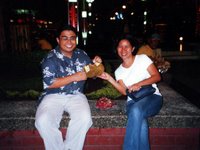Visiting the Agusan Marsh Wildlife Sanctuary is a beautiful experience. But it's not for the faint-hearted given the difficulties in reaching this picturesque wetland.
Several years ago, I stayed overnight with the Manobo community at Sitio Panlabuhan, Loreto, Agusan del Sur, and helped the community create a tourism program for their ancestral domain. This time, I returned with my students to let them experience life in the floating community. I had warned them that traveling to the Agusan Marsh was not easy. And amenities at the Sitio Panlabuhan Floating Community were close to none. But it was worth it, especially with the warm reception of the Manobos who live there.
Related post: Overnight with the Manobo community of Agusan Marsh
We took the first flight to Butuan City and visited the various archaeological sites of the city. We also shopped for sleeping mats which we donated to Sitio Panlabuhan. It's best to leave the rest of your luggage at the hotel you will stay at in Butuan and bring waterproof overnight bags for the trip to Agusan Marsh. Dry bags are highly recommended for cameras and mobile phones.
The plan was to leave for Bunawan, the jump-off point for the Agusan Marsh, after lunch. But we ended up taking the 2:15 p.m. bus to Davao City (Bunawan is along the way). They say the trip from Butuan to Bunawan is between two to three hours, for private vehicles maybe. On a bus however, it takes close to four hours with all the stops. So we arrived in Bunawan after sunset, which you should definitely avoid. If you are coming from Butuan, it is best to leave by 11 a.m.
It takes another three hours by river boat to get to the Agusan Marsh from Bunawan. I realized what we did was quite dangerous, traveling by boat in the dark. We only had flashlights to help us avoid logs and other debris on the river. To make matters worse, it started to rain really hard. It felt like those jungle expeditions you see on TV, especially since crocodiles could just be around the corner.
We had to park the pump boats and cross a small strip of land, under the rain and in the dark, to get to the lake of Sitio Panlabuhan where paddle boats were waiting to take us to the lodge. Note that you have to wear shorts and slippers or sandals since you may have to wade in the water depending on how high water levels are.
At 9 p.m., we finally arrived at our lodge, soaking wet from the rain. After changing into dry clothes, the community served us a really delicious dinner, fresh catch from the Agusan Marsh. If you do not eat fish or for variety, you can buy canned goods in Butuan or Bunawan which they can cook for you.
Since it had just rained, we had cool weather the whole evening. Don't forget the mosquito repellent if you want a good night's sleep.
When you arrive, the head of the community leads a ritual requesting their ancestors to grant you safe entrance into their community. This is very important to them. And they say that if it is not done, something bad will happen to the visitor. Since we arrived really late, the ritual was done as soon as we woke up.
After breakfast, we were brought by paddle boat to other parts of Sitio Panlabuhan where we enjoyed picturesque views of the Agusan Marsh. I noticed though there were not as many birds as my previous visit since it was still October. If you want to see migratory and endemic birds, come during the cold months from late November to early February.
There's an abundance of water hyacinths at the Agusan Marsh. It's actually an invasive species and tends to clog the marsh. The Manobo ladies of Sitio Panlabuhan have been able to weave dried water hyacinths into beautiful bags. If you want to order bags or schedule a trip, contact Maritess Babanto at (0930) 5287194.
The group had an early lunch before leaving for Bunawan. We were back in Butuan by 6 p.m. What an adventure it was, especially for the first-timers!
Several years ago, I stayed overnight with the Manobo community at Sitio Panlabuhan, Loreto, Agusan del Sur, and helped the community create a tourism program for their ancestral domain. This time, I returned with my students to let them experience life in the floating community. I had warned them that traveling to the Agusan Marsh was not easy. And amenities at the Sitio Panlabuhan Floating Community were close to none. But it was worth it, especially with the warm reception of the Manobos who live there.
Related post: Overnight with the Manobo community of Agusan Marsh
We took the first flight to Butuan City and visited the various archaeological sites of the city. We also shopped for sleeping mats which we donated to Sitio Panlabuhan. It's best to leave the rest of your luggage at the hotel you will stay at in Butuan and bring waterproof overnight bags for the trip to Agusan Marsh. Dry bags are highly recommended for cameras and mobile phones.
The plan was to leave for Bunawan, the jump-off point for the Agusan Marsh, after lunch. But we ended up taking the 2:15 p.m. bus to Davao City (Bunawan is along the way). They say the trip from Butuan to Bunawan is between two to three hours, for private vehicles maybe. On a bus however, it takes close to four hours with all the stops. So we arrived in Bunawan after sunset, which you should definitely avoid. If you are coming from Butuan, it is best to leave by 11 a.m.
It takes another three hours by river boat to get to the Agusan Marsh from Bunawan. I realized what we did was quite dangerous, traveling by boat in the dark. We only had flashlights to help us avoid logs and other debris on the river. To make matters worse, it started to rain really hard. It felt like those jungle expeditions you see on TV, especially since crocodiles could just be around the corner.
We had to park the pump boats and cross a small strip of land, under the rain and in the dark, to get to the lake of Sitio Panlabuhan where paddle boats were waiting to take us to the lodge. Note that you have to wear shorts and slippers or sandals since you may have to wade in the water depending on how high water levels are.
At 9 p.m., we finally arrived at our lodge, soaking wet from the rain. After changing into dry clothes, the community served us a really delicious dinner, fresh catch from the Agusan Marsh. If you do not eat fish or for variety, you can buy canned goods in Butuan or Bunawan which they can cook for you.
Since it had just rained, we had cool weather the whole evening. Don't forget the mosquito repellent if you want a good night's sleep.
When you arrive, the head of the community leads a ritual requesting their ancestors to grant you safe entrance into their community. This is very important to them. And they say that if it is not done, something bad will happen to the visitor. Since we arrived really late, the ritual was done as soon as we woke up.
After breakfast, we were brought by paddle boat to other parts of Sitio Panlabuhan where we enjoyed picturesque views of the Agusan Marsh. I noticed though there were not as many birds as my previous visit since it was still October. If you want to see migratory and endemic birds, come during the cold months from late November to early February.
There's an abundance of water hyacinths at the Agusan Marsh. It's actually an invasive species and tends to clog the marsh. The Manobo ladies of Sitio Panlabuhan have been able to weave dried water hyacinths into beautiful bags. If you want to order bags or schedule a trip, contact Maritess Babanto at (0930) 5287194.
The group had an early lunch before leaving for Bunawan. We were back in Butuan by 6 p.m. What an adventure it was, especially for the first-timers!



























